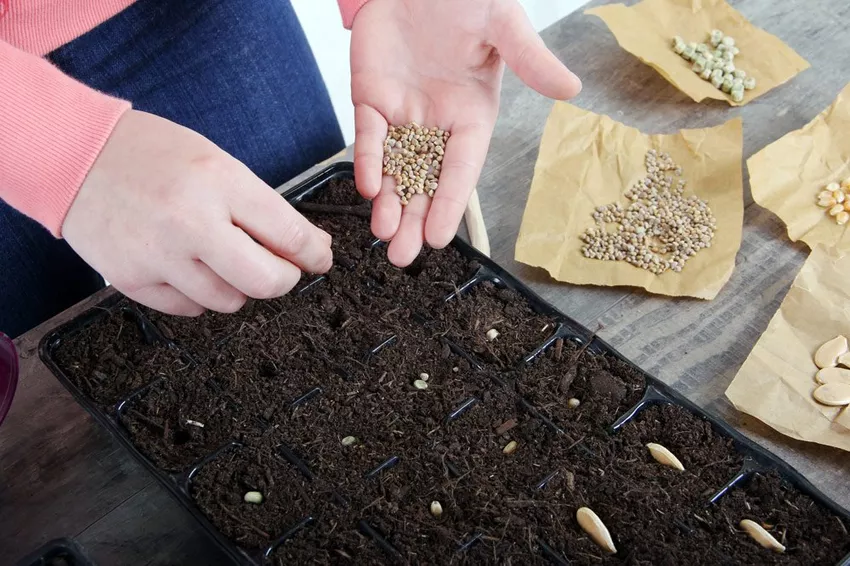Many plants are annuals and have to be resown every year. It's handy if you win the seeds yourself.

You will find a large selection of seeds for various crops and flowering plants on the market. But if you want to save money, you can also harvest your seeds yourself. In the following we tell you which plants you can get seeds from and how to do it.
From which plants can seeds be obtained?
In general, one can state that seeds can only be obtained from plants with fertilized flowers. This is theoretically even possible with cabbage or lettuce. However, since these are harvested before flowering, no seeds can be obtained. However, you can leave a few specimens and wait for them to flower.
Tip: If you have planted hybrids, you can also gain from these seeds. However, these are not pure varieties, so that the resulting plants can differ greatly from the mother plant. You can recognize such hybrids by the suffix "F1".
There are some plants that cannot be pollinated. These include, on the one hand, plants with sterile and double flowers and, on the other hand, the flowers of exotic plants such as the passion flower. If you want to propagate these plants, this is not possible by sowing!
Harvest Seeds
The process of obtaining seeds is generally similar for the different plants. But first you have to look for he althy and strong plants from which you can later take the seeds. Then do the following:
1. Take good care of the selected plants and fertilize them sufficiently.
2. Wait for flowering and collect the ripe fruits or seeds.
3. Clean the seeds from the pulp or any other contamination.
4. Dry the seeds and bottle them. Don't forget to label the seeds.
5. Store the seeds in a cool, dry place until ready to sow. Please note the lifespan of the seeds!
Tip: Never remove the seeds from diseased plants. Such seeds are often of poorer quality and can also transmit diseases!
Harvest Flower Seeds

The seeds of many flowers ripen in autumn and can then also be gathered. To do this, cut off the entire seed head and dry it indoors. The seeds then come off easily and you can fill them in bags or jars.
Tip: If you want to sow hardy perennials, the seeds need a cold stimulus so that they start to germinate.
Harvest Vegetable Seeds
Vegetable seeds form in fruits, pods, pods or on the inflorescence, depending on the vegetable. Accordingly, the extraction of the seeds differs here:
Pulses
Lentils, peas or beans are examples of legumes. They are all self-pollinating and can be multiplied by seed. The seeds form in pods after flowering. Wait until fall to harvest the seeds, when the pods are brown, dried up and beginning to rustle. Then remove the pods from the already dead plants and dry them indoors. You can then take the seeds out of the pods and store them in winter.
Root Vegetables
Root and tuber vegetables such as carrots, celery, fennel or parsnips usually flower in the second year (carrots sometimes in the first). So don't harvest the vegetables in the first year. In spring, long, umbel-shaped inflorescences form, which are pollinated by insects. The seeds are ripe in autumn and fall off quickly during drought. You should therefore harvest the umbels in good time and dry the seeds indoors.
Leaf Vegetables
Both chicory and lettuce belong to the daisy family. These are among the foreign pollinators. So you need more plants of the same variety so that pollination can take place. In October, the flowers mature into achenes. So that the seeds, which are reminiscent of dandelion seeds, don't get carried away by the wind, collect them as soon as the little "parachutes" unfold between September and October.
Tip: If there are plants of the same species of a different variety within a radius of three kilometers, crossbreeding can occur.
Leaf vegetables also include cabbage plants such as rocket, radishes or white cabbage. In most cases, they also only flower in the second year and, like the daisy family, are cross-pollinators. However, after pollination, elongated pods with round, black seeds form in them. You can cut these off from mid-September and dry them indoors,by removing the seeds from the pods.
Fruit Vegetables:

In addition to nightshade plants such as tomatoes, peppers or aubergines, fruit vegetables also include cucurbits such as pumpkin, zucchini, cucumber or melon. As the name suggests, the seeds are surrounded by a pulp. They can be easily removed and dried on a kitchen towel after cleaning.
» Reading tip: Obtaining and drying tomato seeds - 2 methods
Tip: If you want to get seeds from cucumbers or courgettes, you should only harvest the fruits in autumn.
The nightshade family is mostly self-pollinating. To support self-pollination, you can shake the open flowers slightly in the morning to spread the pollen on the stigma.
Cucurbits are cross-pollinators. They depend on insects to pollinate the flowers. Alternatively, wind pollination is also possible. However, the problem here is that pollination does not always take place with pollen of the same variety. As a result, the offspring are often not pure.
Onions
In addition to onions and leeks, garlic also belongs to the onion family. In the summer of the second year, several long flower stalks with spherical flower heads form. Cross-pollination produces black, angular seeds. To prevent them from falling out, harvest the entire inflorescence when the bracts around the seeds are slowly drying up and leave them to dry at room temperature for about ten days.